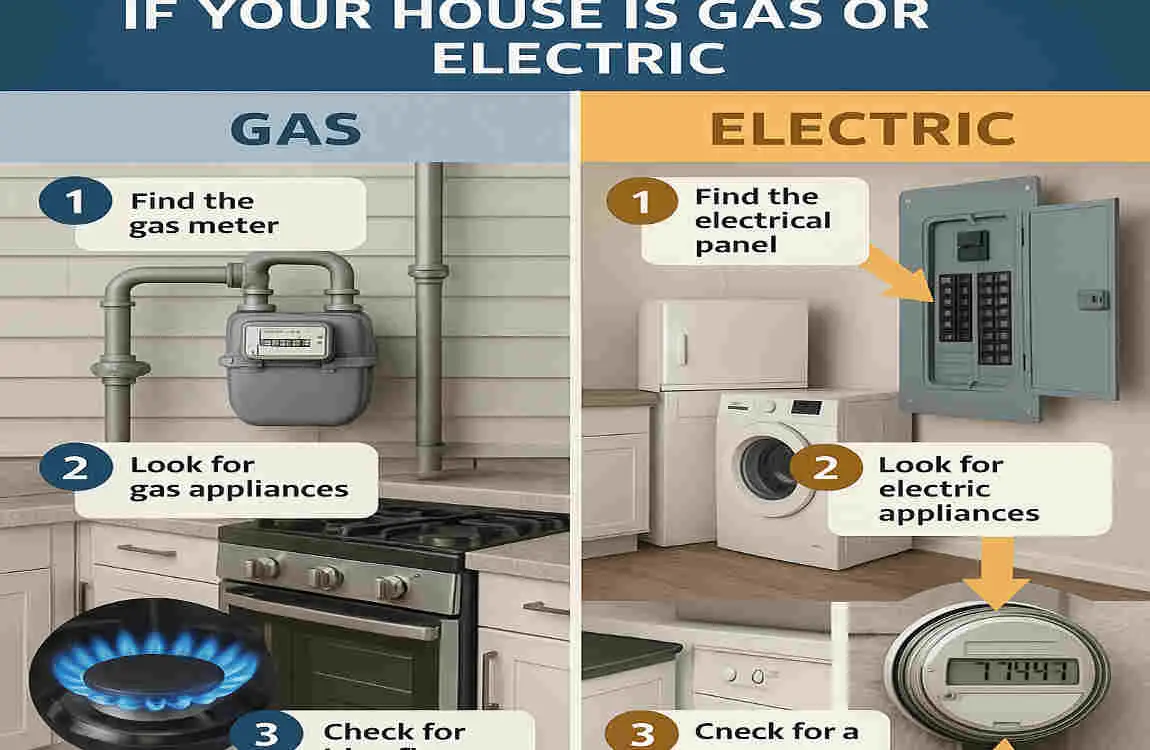Hey there, homeowner! Have you ever paused in the middle of your day and wondered, Is my house gas or electric? It’s a question that pops up more often than you might think, especially when you’re dealing with rising energy bills, planning a kitchen remodel, or just trying to stay safe. Knowing whether your home runs on gas or electricity isn’t just trivia—it’s key to keeping things running smoothly, saving money, and avoiding potential hazards.
Think about it: your home’s energy source affects everything from how you cook dinner to how you heat your living room on a chilly night. If you’re like most people, you might not have given it much thought until something goes wrong, like a sudden spike in your utility bill or a weird smell in the basement.
Safety comes first, of course. Gas systems can be efficient but require extra caution due to risks such as leaks, while electric ones are often simpler but may incur higher costs in some areas. Regardless of the circumstances, understanding your home’s energy type empowers you to make wise, informed choices. Stick with us, and you’ll have the answers you need.
Understanding Gas and Electric Utilities in Homes
Let’s kick things off by getting clear on what we’re talking about. When we say “gas or electric” in a home context, we’re referring to the primary energy sources that power your everyday appliances and systems. It’s not about whether your house has lights (that’s always electric!), but rather how things like heating, cooking, and hot water work.
What Are Gas Utilities?
Gas utilities typically mean natural gas, which is a fossil fuel piped into your home from underground lines. It’s colorless and odorless in its pure form, but companies add a rotten-egg smell for safety so you can detect leaks. In homes, gas often fuels furnaces for heating, stoves for cooking, water heaters for showers, and even dryers for laundry. Imagine flipping on your oven and hearing that familiar whoosh—that’s gas igniting.
Why do people love gas? It’s usually cheaper per unit than electricity in many regions, and it provides instant heat. For example, a gas stove lets you control the flame precisely, which chefs swear by. But it’s not all roses. Gas requires good ventilation to prevent buildup, and installation can be more expensive upfront.
What Are Electric Utilities?
On the flip side, electric utilities rely on electricity from the power grid to run your home’s systems. This means your heater might be an electric furnace, your stove could have coils that glow red-hot, and your water heater uses heating elements submerged in the tank. Electricity is everywhere—it’s what powers your fridge, lights, and outlets—but here, we’re focusing on the big-ticket items like HVAC (that’s heating, ventilation, and air conditioning) and appliances.
Electric setups are straightforward: plug it in, and it works. They’re often seen as cleaner since they don’t produce emissions right in your home (though the power plant might). Drawbacks? Electricity can be more expensive, especially during peak hours, and it might take longer to heat things compared to gas.
Benefits and Drawbacks: Gas vs. Electric
Let’s compare the two head-to-head. Gas wins on speed and cost for heating—think lower bills in winter if you’re in a cold climate. But electric shines in ease of use and safety; no worries about gas leaks. Environmentally, electric homes can pair well with solar panels for a greener footprint, while gas contributes to carbon emissions.
On the flip side, gas appliances might last longer with proper care, but they need annual check-ups. Electric ones are low-maintenance but could spike your bill if you’re running a lot of high-power devices. Which one’s better? It depends on your location, lifestyle, and budget. For instance, if you live in an area with cheap natural gas, sticking with it makes sense.
Why Identify Your Home’s Energy Source?
Knowing if your house is gas or electric helps with budgeting. You can predict bills better and spot inefficiencies. Safety-wise, gas homes need carbon monoxide detectors, while electric ones focus on overload prevention. Plus, for maintenance, you’ll know what kind of repairs to expect—gas lines versus wiring fixes.
Imagine selling your home: buyers often ask about energy types for efficiency reasons. Or, if you’re upgrading to smart appliances, compatibility is crucial. Bottom line, this knowledge puts you in control. Have you checked yours yet? It’s easier than you think.
Signs That Indicate Your House Is Gas or Electric
Spotting whether your home leans toward gas or electric doesn’t require a detective’s hat—just a keen eye and a bit of exploration. We’ll cover the telltale signs, from outdoor meters to indoor appliances. Remember, these clues aren’t foolproof alone, but together they paint a clear picture. Let’s dive in.
Spotting Gas Utilities: Key Visual Cues
Start outside. Look for a gas meter, usually a boxy device attached to your home’s exterior wall. It’s often gray or green, with dials or a digital readout showing usage in cubic feet. If you see one, bingo—your house likely has gas service.
Head inside next. In the basement or utility room, check for thick pipes painted black or yellow—these are gas lines. They might snake along walls or floors, connecting to appliances. Now, inspect those appliances. A gas stove will have burners with grates and possibly a pilot light—a small, constant flame. Water heaters? Look for a vent pipe on top, which exhausts fumes.
Don’t forget the smell test (safely!). Gas appliances give off a faint, distinct odor when in use. If your dryer has a flexible metal vent hose instead of a simple electric cord, it could be gas-powered.
Spotting Electric Utilities: What to Look For
No gas meter outside? That’s a strong hint toward electric. Instead, you’ll find an electric meter, often a glass-domed device with spinning dials or a digital screen measuring kilowatt-hours.
Inside, the heart of an electric home is the circuit breaker box—a metal panel with switches that control power flow. It’s usually in the garage, basement, or hallway. No gas pipes nearby? Electric it is.
Check appliances: An electric stove has flat coils or a smooth glass top, powered by a thick cord plugged into a 240-volt outlet. Heaters might be baseboard units or forced-air systems without vents. Water heaters will have electrical wiring entering the top, no exhaust needed.
Interpreting Utility Bills and Other Clues
Your bills are a goldmine. Gas bills list charges for therms or cubic feet, separate from electricity’s kilowatt-hours. If you only get one bill from an electric company, that’s a clue.
Visual examples help: Picture a gas meter as a sturdy outdoor clock, while an electric one looks like a high-tech speedometer. For appliances, gas models often have labels indicating “Natural Gas” or “LP” (for liquefied petroleum gas). Electric? Look for voltage ratings like 120V or 240V.
Common Pitfalls and Pro Tips
Sometimes homes mix both—gas for cooking, electric for everything else. Don’t assume based on one sign. If you’re renting, ask your landlord. Always prioritize safety: if you suspect gas but aren’t sure, avoid open flames during inspections.
Here’s a quick list of places to look:
- Outdoor areas: Meters on the side of the house.
- Kitchen: Stove type and connections.
- Utility spaces: Pipes vs. wires.
- Bills: Separate line items for gas.
To make it even more straightforward, let’s use a simple table comparing signs:
Sign Gas Indicator Electric Indicator
Meter Type Box with gas dials , Glass dome with electric readout
Appliance Connection , Pipes and vents , Thick cords and outlets
Heating System Furnace with pilot light , Baseboard or electric coils
Bill Details Charges in terms Charges in kWh
By spotting these, you’re well on your way. Ever noticed something odd in your home? Share in the comments!
Step-by-Step Guide to Identify If Your House Is Gas or Electric

Ready to roll up your sleeves? This is the meat of our guide—a hands-on, step-by-step process to answer that nagging question: is my house gas or electric? We’ll take it slow, explaining each step in detail so you can follow along safely at home. No fancy tools needed, just curiosity and caution. If at any point you’re unsure, stop and call a professional. Let’s begin.
Locate Your Utility Meters Outside and Inside
First things first: head outdoors. Walk around your house’s exterior, focusing on the sides or back where utilities enter. Look for meters. A gas meter is typically a rectangular box, about knee-high, with pipes connected and a gauge showing usage. It’s often labeled with your gas company’s name.
No gas meter? Scan for the electric meter—usually a round, glass-covered device mounted on the wall. Note its location; if it’s the only one, your home might be all-electric.
Inside, check the basement, garage, or utility closet. Gas meters sometimes hide indoors in older homes. Take photos for reference. This step sets the foundation—meters are like your home’s energy ID card.
Pro tip: Do this during daylight for safety, and avoid tampering with anything sealed.
Inspect Major Appliances for Labels and Features
Now, let’s check your big appliances: oven, heater, dryer, and water heater. Start in the kitchen. Open your stove—does it have gas burners with igniters, or electric elements? Look for labels on the back or inside; words like “gas” or “propane” scream gas, while “electric” or voltage specs point to power.
Move to the water heater, often in a closet or basement. Gas models have a control knob for the pilot light and a vent pipe. Electric ones? Just wiring and no vent. For dryers, peek behind: a gas dryer connects via a flexible pipe, an electric dryer via a heavy-duty plug.
Heaters vary—furnaces with gas valves vs. electric panels. Make a checklist as you go. This step reveals how your daily life is powered.
Check Your Home’s Electrical Panel
Find your circuit breaker box—it’s the gray metal door with flip switches. Open it carefully (turn off power if needed, but usually, it’s safe to look). Count the breakers; a home with heavy electric use (like an electric furnace) will have more, often labeled for specific appliances.
No signs of gas integration here? That’s a vote for electric. This helps understand your electric load—too many high-draw items could mean no room for gas conversions later.
Read Your Utility Bills Carefully
Grab your last few bills—physical or online. Scan for sections: Electricity is billed in kilowatt-hours (kWh), gas in therms or cubic feet. If there’s a “gas delivery” charge, you have gas service. Only electric? You’re likely all-electric.
Compare months; winter spikes in gas suggest heating use. This paper trail confirms physical signs.
Examine Visible Gas Piping or Electric Wiring
Tour your home again. Look for black iron pipes (gas) running along walls or ceilings, especially near appliances. Electric wiring is thinner, often in conduits or hidden.
In crawl spaces or attics, gas pipes are rigid, and electric pipes are flexible. No pipes? Electric wins.
Use a Carbon Monoxide Detector for Gas Suspicions
If gas signs appear, install or check a carbon monoxide (CO) detector. These beep if levels rise from faulty gas appliances. Test it monthly—it’s a lifesaver.
This step isn’t diagnostic, but it adds safety while confirming the presence of gas.
Contact Your Utility Provider for Confirmation
Still unsure? Call your utility company. Give your address; they’ll confirm services. It’s free and authoritative.
Pro tips throughout: Wear gloves for dusty areas, use a flashlight, and never force open sealed parts. If you smell gas (rotten eggs), evacuate and call emergency services immediately.
Here’s a bulleted list of safety dos and don’ts:
- Do: Document findings with notes or photos.
- Do: Involve a family member for double-checking.
- Don’t: Ignore warning labels on appliances.
- Don’t: Attempt repairs yourself—leave that to experts.
Follow these steps, and you’ll know your home’s energy type in no time. How did it go for you?
Why It Matters to Know Your House’s Energy Source
So, you’ve figured out if your house is gas or electric—great job! But why bother? Let’s explore the real-world impacts. This knowledge isn’t just for show; it shapes your daily life, wallet, and even the planet.
Impact on Home Maintenance and Repairs
Gas homes need regular tune-ups for appliances to prevent leaks or inefficiencies. Think annual furnace inspections to keep things humming. Electric setups? They’re simpler—replace a heating element, and you’re good. Knowing this helps you schedule the right pros and avoid costly surprises.
For repairs, gas might involve plumbers certified for lines, while electric calls for electricians. Prepare ahead, and you’ll save time and stress.
Cost Implications: Bills and Efficiency
Money talks. Gas is often cheaper for heating, but prices fluctuate with the markets. Electric bills can be steadier but higher in peak seasons. Understand your type to budget better—maybe switch to energy-efficient models.
Appliance efficiency matters too. A gas water heater heats faster, potentially lowering costs, while electric ones pair with timers for savings.
Environmental Considerations
Gas burns fossil fuels, adding to your carbon footprint. Electric? It depends on your grid—if it’s renewable-heavy, you’re greener. Think about it: switching to electric could align with solar panels for near-zero emissions.
Safety Concerns and Precautions
Gas risks include leaks or CO poisoning—detectors are a must. Electric hazards? Overloads or faulty wiring leading to fires. Know your setup to install the proper safeguards.
Preparing for Upgrades or Renovations
Planning a remodel? Gas might limit options if lines aren’t in place, while electric is flexible. This information guides eco-upgrades, such as heat pumps over gas furnaces.
Ultimately, this awareness empowers you. What’s your next home project?




